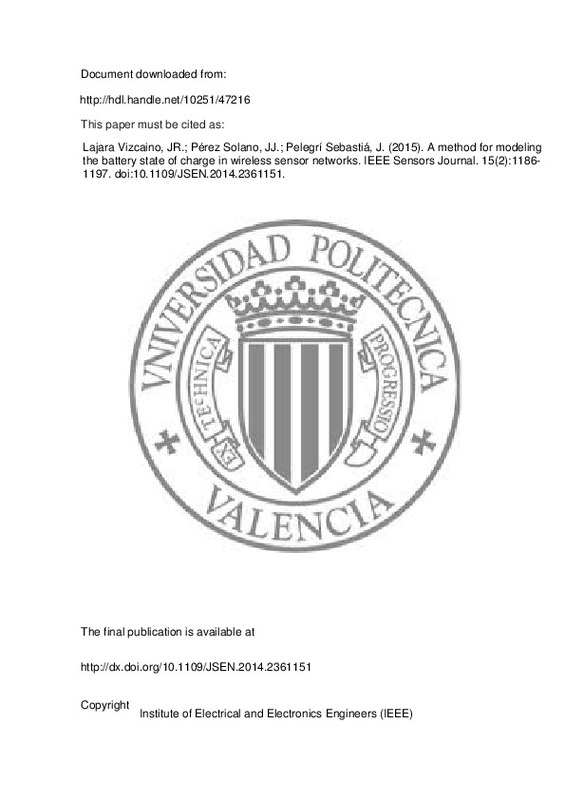Lajara Vizcaíno, JR.; Pérez Solano, JJ.; Pelegrí Sebastiá, J. (2015). A method for modeling the battery state of charge in wireless sensor networks. IEEE Sensors Journal. 15(2):1186-1197. https://doi.org/10.1109/JSEN.2014.2361151
Por favor, use este identificador para citar o enlazar este ítem: http://hdl.handle.net/10251/47216
|
Título:
|
A method for modeling the battery state of charge in wireless sensor networks
|
|
Autor:
|
Lajara Vizcaíno, José Rafael
Pérez Solano, Juan José

 Pelegrí Sebastiá, José
Pelegrí Sebastiá, José
|
|
Entidad UPV:
|
Universitat Politècnica de València. Departamento de Ingeniería Electrónica - Departament d'Enginyeria Electrònica
Universitat Politècnica de València. Instituto de Investigación para la Gestión Integral de Zonas Costeras - Institut d'Investigació per a la Gestió Integral de Zones Costaneres
|
|
Fecha difusión:
|
|
|
Resumen:
|
In this paper we propose a method for obtaining an analytic model of the battery State-of-Charge (SoC) in wireless sensor nodes. The objective is to find simple models that can be used to estimate accurately the real battery ...[+]
In this paper we propose a method for obtaining an analytic model of the battery State-of-Charge (SoC) in wireless sensor nodes. The objective is to find simple models that can be used to estimate accurately the real battery state and consequently the node lifetime. Running the model in the network nodes, we can provide the motes with the required information to implement applications that can be considered as battery-aware. The proposed methodology reduces the computational complexity of the model avoiding complicated electrochemical simulations and treating the battery as an unknown system with an output that can be predicted using simple mathematical models. At a first stage, during a setup period, the method starts with the measurement of several battery parameters under different environmental and operational conditions. After that, the method uses the previous collected data for building mathematical models, considering the linear regression or the multilayer perceptron as the most appropriated. Finally, the models are validated experimentally with new measures. Results show the suitability of the method that produces accurate and simple models, capable of being implemented even in low-cost and very constrained real motes
[-]
|
|
Palabras clave:
|
Batteries modeling
,
Batteries State-of-Charge
,
Energy
,
Wireless sensor networks
|
|
Derechos de uso:
|
Reserva de todos los derechos
|
|
Fuente:
|
IEEE Sensors Journal. (issn:
1530-437X
)
|
|
DOI:
|
10.1109/JSEN.2014.2361151
|
|
Editorial:
|
Institute of Electrical and Electronics Engineers (IEEE)
|
|
Versión del editor:
|
http://dx.doi.org/10.1109/JSEN.2014.2361151
|
|
Código del Proyecto:
|
info:eu-repo/grantAgreement/GVA//GV05%2F043/
info:eu-repo/grantAgreement/UPV//PAID-06-06-002-61/
|
|
Descripción:
|
(c) 2015 IEEE. Personal use of this material is permitted. Permission from IEEE must be obtained for all other users, including reprinting/ republishing this material for advertising or promotional purposes, creating new collective works for resale or redistribution to servers or lists, or reuse of any copyrighted components of this work in other works.
|
|
Agradecimientos:
|
This work was supported by the I+D+i Program, Generalitat Valenciana, through the Research and Development under Project GV05/043 and in part by the Vicerrectorado of Investigation, Development and Innovation, Universidad ...[+]
This work was supported by the I+D+i Program, Generalitat Valenciana, through the Research and Development under Project GV05/043 and in part by the Vicerrectorado of Investigation, Development and Innovation, Universidad Politecnica de Valencia, under Grant PAID-06-06-002-61.
[-]
|
|
Tipo:
|
Artículo
|







![[Cerrado]](/themes/UPV/images/candado.png)


